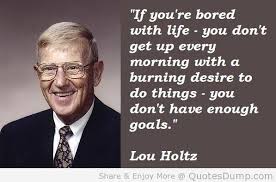In the past few editions of Coaching Insights you have been introduced to the GROW concept of coaching techniques. Beginning this week, and over the course of the next few weeks we will delve into each  letter representation of the acronym in more depth and then we will tie it all together into the overall GROW methodology.
letter representation of the acronym in more depth and then we will tie it all together into the overall GROW methodology.
Keep in mind, when it comes to coaching, if you are not working from a proven model it’s very difficult to be effective. If you don’t have a well thought out program, you'll end up directing and prodding and have little to show for it in the end.
Last week I introduced you to a broad overview of the GROW Model:
Goal – The End point; what the person would like to achieve.
Reality – The current status of where you are now, and how you have arrived there.
Obstacles/ Options – The variables that keep the person from reaching their goals; the choices one has make to overcome the obstacles.
Way Forward – The action steps that will lead to the successful completion of the goal.
If you were to just use the above skeleton outline and nothing more, you would provide much more meaningful and productive coaching benefits than you would without a model. But, the difference between mediocre and excellent coaching will be achieved by developing a deeper understanding of the impact each step can have when it is woven into your coaching style.
Today, we will begin with the first step in the process. G = Goal.
It is difficult to even begin a day without setting goals; take a shower, brush your teeth. This holds true in coaching and defining relationships as well, just on a different scale.
The Goal phase isn't as simple as it might sound. It must be arrived at with thoughtful reflection and keen awareness of a number of factors. Your mentee might have an idea where they want to ultimately end up, but they may need help in defining this elusive Goal. Your responsibility is to help them seek a measurable, concrete objective; one that is so well outlined that they will know explicitly when it has been reached.
The goal should, therefore, not be arbitrary. When an individual does that, it will render a goal where there is little if any personal ownership or "buy-in." How do you achieve this? You find a way to personalize the goal through simple but directed conversation – the first step in any good coaching program. What motivates them, what makes them happy, what frustrates them? What are their short term goals versus long term goals? Why are they doing this in the first place? What do they hope to gain? What are their expectations? This is perhaps the most important part of the GROW program. Get to know the individual; take some time now for better success later.
Once this is done, you've tackled the most difficult, but essential piece to the Goal stage of coaching, and you have added to your relationship the knowledge of what motivates this individual. This is a priceless accomplishment when it comes to coaching, because goals can sometimes be empty without a greater motivation behind them.
Now that you have the ultimate goal, press for a specific, measurable, and time based goal. This goal has to make its arrival clear and worthy of celebration.
Next week, I'll delve into the next phase of the GROW model- Reality. This is where humility, honesty and vulnerability will all be required.
I'll leave you with a quote from one of the greatest and most quoted coaches of our time Lou Holtz:
Join the WorkPuzzle Discussion at the Tidemark Online Community (TMOC)
Engage in the WorkPuzzle discussion by joining the TMOC private social network. Commenting on a public blog like WorkPuzzle can be a little intimidating, so why not join the discussion inside the privacy of the TMOC discussion group?
By joining TMOC, you'll get to see who else is in the group and your comments will only be seen by those whom you trust. Joining TMOC is quick, easy, and free (no kidding…this takes less than 2 minutes). To get started, click here.
Already of a member of TMOC? If so, join the WorkPuzzle Dialog Group by clicking on the WorkPuzzle Group icon on the left side of your TMOC homepage. Questions? Email the WorkPuzzle editor (workpuzzle@hiringcenter.net) and we'll walk through the process.
 Editor's Note: This article was written by Dr. David Mashburn. Dave is a Clinical and Consulting Psychologist, a Partner at Tidemark, Inc. and a regular contributor to WorkPuzzle.
Editor's Note: This article was written by Dr. David Mashburn. Dave is a Clinical and Consulting Psychologist, a Partner at Tidemark, Inc. and a regular contributor to WorkPuzzle.

